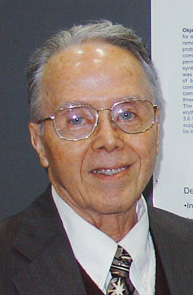Article by Ostrow Alumnus and Hall of Fame Member Honored in JADA

Posted
18 Oct 13
In 1963, Ostrow School of Dentistry alumnus Rafael “Ray” Bowen DDS ’53 published “Properties of a Silica-Reinforced Polymer for Dental Restorations” in the Journal of the American Dental Association. Essentially introducing the idea of dental composites to the world, it would eventually be considered one of the most pioneering dental articles ever published in the journal.
In honor of JADA’s centennial year, the journal has republished Bowen’s article as well as other landmark dental studies, pairing each of them with expert commentary about the study’s impact on the dental profession. Bowen’s article appeared in the August 2013 issue of JADA and was discussed by Stephen C. Bayne, professor at the University of Michigan School of Dentistry and member of the JADA Editorial Board.
Bowen is currently working to improve dental composite materials in the American Dental Association Foundation’s Research Center located within the National Institute of Standards and Technology (NIST) in Gaithersburg, MD. At the time he wrote the article, he says he thought there should be esthetic direct dental restorative materials that would be more durable than the silicate cements and unfilled methyl methacrylate resins that were then available, but he didn’t know what his work would eventually lead to.
“Epoxy resins were reported to be strongly and durably adhesive to most materials. It seemed to me that a mixture of a maximum amount of amorphous silica combined with a minimum amount of self-curing epoxy resin might be used as a composition for the direct restoration of dental cavities,” Bowen says. “When I was working on this highly reinforced resin concept in the late 1950’s and beyond, I had no idea as to whether such materials would turn out to become commercially produced and widely utilized.”
From 1953 to 1956, while practicing dentistry in San Diego, Bowen began conducting materials research in his spare time, using his screened-in porch as a makeshift laboratory. He wrote and presented a paper on the work, after which he was invited to join the American Dental Association’s Research Unit, then associated with the National Bureau of Standards in Washington, D.C., by Dr. George Paffenbarger (for whom the Paffenbarger Research Center would be named).
“The dental school prepared me to practice dentistry, but it was also influential in training for paying attention to fine details, which would later be essential in scientific endeavors,” he says. “The clinical staff was especially influential because of their high standards with respect to ideal restorative procedures.”
Ostrow School of Dentistry Dean Emeritus Harold Slavkin DDS ’65, met Bowen through Professor Lucien Bavetta, their mutual mentor. Slavkin, former director of the National Institute for Dental and Craniofacial Research, says Bowen’s work fundamentally changed dentistry. “Before then, there weren’t a lot of things that dentistry could do,” he says.
Beyond Bowen’s revolutionary work with composite restorative materials, he is also credited with the invention of dental sealants used to prevent decay. His far-reaching impact on the profession led to several honors, including his induction to the Ostrow School of Dentistry Hall of Fame in 1997.
Slavkin cites Bowen’s long career as a testament to the importance of translational science. “When you support basic science discoveries and put them together for dental applications, you have clinical practices that are informed by science and evidence,” he says.